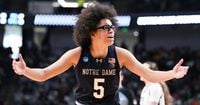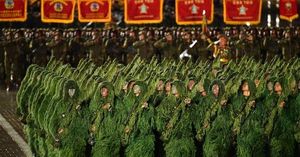The world of women’s basketball is buzzing with anticipation, tension, and a healthy dose of celebration as the Las Vegas Aces bask in the glory of a third championship in four seasons, while the WNBA stares down the barrel of a pivotal moment in its history. With the league’s Collective Bargaining Agreement (CBA) set to expire in just days, players, coaches, and fans alike are watching closely to see how negotiations unfold—and what the future holds for the sport’s brightest stars.
Jackie Young, the dynamic guard for the Aces, has become one of the most prominent voices in the ongoing CBA discussions. Fresh from hoisting another championship trophy, Young isn’t just relishing her team’s victory; she’s using her platform to demand change. During a lively promotional appearance at a Las Vegas Raising Cane’s restaurant earlier this week, Young didn’t mince words about what she and her fellow athletes want: fair compensation that truly reflects their value to the game.
“Players deserve recognition as world-class athletes who have elevated women’s professional basketball to unprecedented heights,” Young stated, echoing a sentiment that’s gaining traction across the league. The timing of her comments couldn’t be more significant. With the Aces’ dominance on full display, Young’s advocacy for improved compensation carries the credibility of someone who’s proven her worth time and again on the court. It’s no secret that the WNBA has experienced a surge in popularity—record attendance, expanded media coverage, and lucrative corporate partnerships have all become the new norm. Yet, as Young and many others have pointed out, player salaries haven’t kept pace with this growth.
Revenue sharing, in particular, has emerged as the battleground issue. While NBA players are guaranteed roughly 50 percent of basketball-related income, WNBA players currently receive a much smaller slice of the pie. “This disparity has become increasingly difficult to justify,” Young emphasized, especially as the league enjoys unprecedented attention and investment. Her stance isn’t just personal; it’s representative of a broader push from the players’ association, which is seeking a fundamental restructuring of how financial success is shared.
But pay isn’t the only sticking point. As the league matures, players are voicing concerns about several other key areas. Charter flight policies, for instance, have become a flashpoint. The current travel arrangements, many argue, are far from optimal for performance or safety. Expanded roster sizes and practice squad provisions are also on the table, with players advocating for more opportunities and a deeper talent pool. And then there’s the matter of maternity and family planning benefits—a uniquely important issue in women’s sports that’s finally getting the attention it deserves.
The negotiation process, however, is anything but smooth. Tensions between players and league leadership are running high, with Commissioner Cathy Engelbert facing mounting criticism. Minnesota Lynx star Napheesa Collier didn’t hold back recently, declaring that the WNBA has “some of the worst leadership in professional sports.” Such candid remarks highlight the depth of frustration among players, who feel that league management has failed to capitalize on the momentum generated by a new wave of rookie sensations and increased fan engagement.
Players are pushing back against arguments that prioritize ownership concerns over athlete welfare and league growth. The commissioner’s office, for its part, is tasked with balancing these demands against the need for long-term financial sustainability. But as more players speak out, it’s becoming clear that incremental changes won’t cut it—comprehensive reform is the order of the day.
Meanwhile, the celebration in Las Vegas continues. The Aces’ victory parade on Friday evening was a jubilant affair, with fans lining the streets to honor their champions. The festivities serve as a stark reminder of what’s at stake. On one hand, there’s the triumph of athletic excellence; on the other, the looming threat of a work stoppage if a new CBA isn’t reached in time. The juxtaposition is almost poetic: players like Young are simultaneously at the pinnacle of their sport and fighting for recognition off the court.
As the CBA deadline approaches, the pressure is palpable. A potential lockout would be a devastating blow, especially at a time when women’s sports are enjoying unprecedented public interest and investment. Young’s willingness to speak candidly about compensation and other issues demonstrates that even the league’s most successful players feel undervalued within the current system. “Meaningful progress on revenue sharing could determine whether the two sides reach an agreement before the current CBA expires,” she noted, underscoring the urgency of the moment.
Elsewhere in the world of women’s basketball, the landscape is shifting in dramatic ways. Olivia Miles, a 22-year-old phenom, made headlines this offseason by transferring from Notre Dame to TCU for her final college season. Miles, who missed the 2023–24 campaign with a torn ACL, opted to forgo the 2025 WNBA Draft in favor of one more year in college—a move aimed at regaining confidence and further developing her game. “I think my main motivation was just to be a year further removed from my knee injury,” Miles explained. “Just gain more confidence mentally, physically, emotionally, and spiritually, too. And just, you know, feel more ready to be a pro.”
Her decision is already paying dividends for TCU. The Horned Frogs, who saw two players—Hailey Van Lith and Madison Conner—drafted in 2025 (the first time in 20 years the program has had multiple draftees in a single year), are now primed for another breakout season. ESPN has Miles pegged as a top-three pick in the 2026 WNBA Draft, with early projections sending her second overall to the Minnesota Lynx. That’s quite the turnaround for a player who was sidelined by injury just a year ago.
TCU Coach Mark Campbell credits recruiting and relationship-building for landing Miles. “It just shows how important it is to recruit those high school kids and build great relationships,” Campbell said. “At least half of our players who transferred in have come because of that.” As the 2025 college basketball season tips off on November 3, all eyes will be on Miles and the Horned Frogs to see if they can continue their upward trajectory.
Back in the WNBA, the Finals matchup provided a fascinating glimpse into the different ways teams can build a contender. With superstars potentially on the move in free agency and player movement reshaping the competitive landscape, uncertainty reigns—but so does optimism. The league finds itself at a crossroads, with the outcome of CBA negotiations likely to shape its future for years to come.
For now, the celebrations in Las Vegas serve as both a testament to what’s possible and a reminder of the work that remains. As the clock ticks down on the current CBA, players, coaches, and fans are united in their hope for meaningful change—and a new era of opportunity for women’s basketball.




